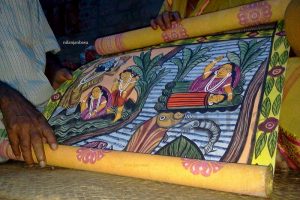India is a diverse country, and such is its culture and heritage. One of India’s lesser known heritage includes the beautiful Paitkar Paintings from Jharkhand.
The village Amadubi situated in the Eastern part of Jharkhand is also called the village of Paitkar. ‘Paitkar’ is the traditional painting of this village, an art form which is present in the village from ancient times. Popularly known as scroll paintings of Jharkhand, this form of painting is prominent in West Bengal, Bihar, Orissa and other adjacent states of India.

Paitkar paintings of jharkhand
Having a common subject of what happens to life after death, these paintings have been long used in for storytelling and in socio-religious customs.
They recount the story of the deeds of gods and goddesses, such as Shiva or Durga from Hindu mythology; or the local deities, such as the snake goddess Manasa. In Santhal tribe of Jharkhand, Paitkar painting is considered to have the capacity to send the wandering souls of the dead to heaven, and thus, help to free them from all pain.
Paitkar paintings may be considered as the variable of Pata painting. The Paitkar artists make the palm leaves as the base of the art and the brushes are made from the hair of squirrel and goat.

Today, in Amadubi, there are 40-45 houses among which a few are practicing Paitkar although most of the villagers know about the art. There have been observed only 3 to 4 artists who still practice this scroll painting. Most of the Amadubi villagers gave up the tradition of Paitkar because it was not economically viable, however, with the right kind of intervention from the government, this age-old heritage of India can be preserved.
– Hitesh kumar


